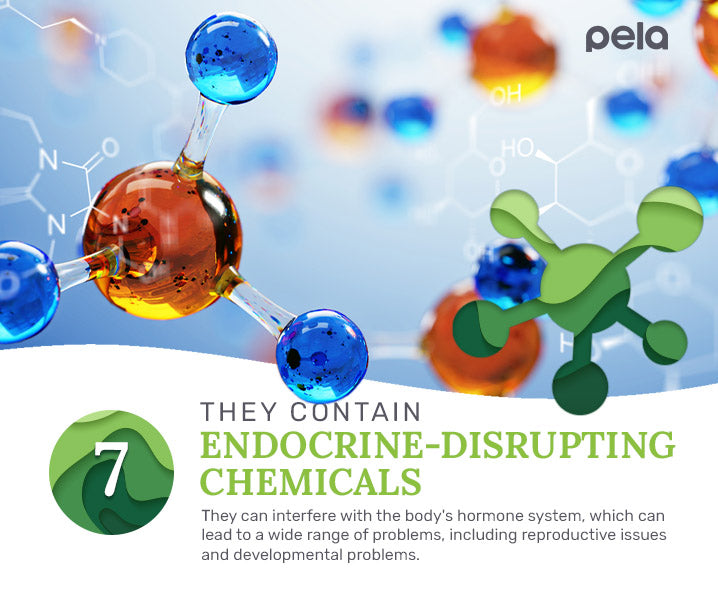
The verdict is in. Plastic smartphone cases are destroying our planet. If you're still using a plastic case, it's time for an upgrade! Here are 14 reasons why we think plastic just doesn't cut it when it comes to phone cases.
1. They Take Hundreds of Years to Decompose
Plastic smartphone cases can take hundreds of years to decompose. That means they will outlive you, your kids, your grandkids, and their grandkids.
Each plastic case adds to the millions of tons of plastic waste that end up in landfills across the world. And unlike many other forms of waste, these plastic cases will continue to sit in landfills long after we are gone.
There is a limit to our planet's landfill space, and the sheer volume of plastic smartphone cases being added to landfills will continue to put a strain on these public resources. Once they inevitably hit their limit, landfills will have no option but to expand into residential areas and precious green spaces.
2. They Have a Limited Life Span
No matter how durable a phone case may be, plastic cases will always have a limited life span. But it's not typical wear-and-tear that takes most cases out of commission. It's the planned obsolescence of the phones they're built to protect.
On average, smartphone users replace their devices every two years. Consequently, as soon as a new phone model is released, the case for the old one is destined to become obsolete.
Even if consumers were to hold on to their phones for as long as possible, there comes a time when every phone model becomes outdated, and phone cases are no longer produced for them. And because new smartphone models typically come in entirely different shapes and sizes, plastic cases can't be reused past a certain point.

3. They're Extremely Difficult to Recycle
While many plastic cases can technically be recycled, the process isn't exactly straightforward.
To start, plastic smartphone cases are usually made from multiple types of plastic, which means they can't be recycled using traditional methods. The plastic has to be manually sorted before it can be sent to a recycling facility, and this extra step often deters would-be recyclers.
Even if plastic cases are properly sorted and sent to a recycling facility, they can only be recycled a few times before they become too degraded to be of any use. This is because plastic smartphone cases are generally made from a type of plastic called polystyrene, which isn't as easily recycled as other materials.
As a result, plastic smartphone cases often end up in landfills, even if they are placed in recycling bins.
Shop Our Compostable Phone Cases4. They're a Hazard to Marine Life
When plastic smartphone cases end up in the ocean, they're often mistaken for food by marine wildlife such as turtles, fish, dolphins, and birds. This can lead to devastating consequences as these animals can starve to death or become entangled in the plastic, which can prevent them from being able to swim or float.
But how do phone cases end up in the ocean? It all starts with plastic pollution on land. When plastic waste is improperly disposed of, it can be carried away by wind and rain to nearby bodies of water. Once in the water, plastic cases can be transported long distances by ocean currents. This is how plastic pollution ends up in every corner of the globe, including some of the most remote and pristine areas on Earth.
One estimate suggests that there are now more than 5 trillion pieces of plastic floating in the world's oceans, and plastic smartphone cases make up a significant portion of this staggering amount.
5. They Release Microplastics Into the Ecosystem
In addition to the plastic pollution they cause, plastic smartphone cases also release microplastics into the environment. Microplastics are tiny plastic particles that are created when larger pieces of plastic degrade. They're so small that they can't be seen with the naked eye, but they are present in a wide range of everyday products, including plastic smartphone cases.
When plastic smartphone cases degrade, they release microplastics into the air, water, and soil. These microplastics can then be ingested by plants, animals, and humans.
There is still a lot of research to be done on the effects of microplastics on the environment and human health, but we do know that they can cause a variety of problems, including DNA damage, oxidative stress, and inflammation.
6. They Contribute to Greenhouse Gas Emissions
The plastic smartphone case industry is also a major contributor to greenhouse gas emissions. For one, plastic cases are made from petroleum, which is a fossil fuel. The extraction and refinement of petroleum release a significant amount of greenhouse gases into the atmosphere.
Plastic smartphone cases are also generally manufactured in Asia, which means they have to be shipped long distances to reach consumers in other parts of the world. This shipping process emits even more greenhouse gases into the atmosphere.
Finally, when plastic smartphone cases end up in landfills, they release methane, a powerful greenhouse gas, as they degrade.
All of these factors contribute to the plastic smartphone case industry's large carbon footprint. Of course, plastic cases aren't the only thing contributing to climate change. But they are a significant source of plastic pollution, and they're something we can all live without.

7. They Contain Endocrine-Disrupting Chemicals
Many plastic smartphone cases contain chemicals known as phthalates, which are used to make plastic softer and more flexible.
Phthalates have been linked to a variety of health problems, including endocrine disruption. This means they can interfere with the body's hormone system, which can lead to a wide range of problems, including reproductive issues and developmental problems.
In addition to phthalates, plastic smartphone cases may also contain other endocrine-disrupting chemicals, such as bisphenol A (BPA). Like phthalates, BPA has been linked to a variety of endocrine-related health problems. Fetuses, infants, and children are particularly vulnerable to the effects of these endocrine-disrupting chemicals as their bodies are still developing.
Browse Our Selection of BPA-Free iPhone Cases8. They Contain Carcinogens
Some plastic smartphone cases also contain carcinogens, which are chemicals that can cause cancer. One of the most common carcinogens found in plastic cases is vinyl chloride.
Vinyl chloride is a chemical used in the production of PVC, a type of plastic often used to make plastic smartphone cases. Exposure to vinyl chloride has been linked to an increased risk of liver cancer, lung cancer, and other types of cancer.
Additionally, plastic smartphone cases may also contain other cancer-causing chemicals, such as brominated flame retardants. These chemicals can leach out of plastic cases and into the environment, where they can be ingested by humans and animals. They have been linked to an increased risk of certain types of cancer, including breast cancer.
9. These Chemicals Can Also Contribute to Diabetes and Heart Disease
In addition to cancer, the chemicals found in plastic smartphone cases have also been linked to other serious health problems, such as diabetes and heart disease.
One of the most common chemicals found in plastic cases, bisphenol A (BPA), has been linked to an increased risk of type 2 diabetes. Because BPA can interfere with the body's hormone system, exposure to the chemical can lead to a variety of problems, including insulin resistance, which is a major factor in the development of type 2 diabetes.
Exposure to BPA and other chemicals found in plastic smartphone cases has also been linked to an increased risk of heart disease. These chemicals can cause a variety of problems, including high blood pressure, hardening of the arteries, and inflammation. All of these factors can contribute to the development of heart disease.

10. Plastic Case = Plastic Packaging
Not only are plastic smartphone cases bad for the environment and our health, but they also generate a lot of plastic packaging waste.
Most plastic cases come packaged in plastic bags or plastic blister packs. These plastic packaging materials are often not recyclable, which means they end up in landfills.
Even if plastic smartphone cases are recycled, the plastic packaging they come in often can't be, which means it still contributes to landfill waste.
11. The Manufacturing Process Leeches Toxic Waste Into the Environment
The plastic smartphone case manufacturing process also leeches toxic chemicals into the environment.
To make plastic smartphone cases, factories use a variety of toxic chemicals, including solvents, plasticizers, and colorants. These chemicals can end up in the air, water, and soil near the factory due to emissions and runoff.
Once released into the environment, these toxic chemicals can contaminate soil and water. As a result, they are ingested by animals and humans. This can lead to a variety of health problems in humans and non-humans alike.
12. Some Phone Cases Are Burned After Disposal
After plastic smartphone cases are disposed of, some are incinerated. This is because plastic cases are made of thermoplastic materials, which means they can be melted and reformed.
Incineration is a process where waste is burned at high temperatures to reduce its volume. When plastic smartphone cases are incinerated, they release a variety of toxic chemicals. These chemicals can include dioxins, furans, and heavy metals.
As a result of the burning process, these chemicals can accumulate in the air in addition to the water and soil near incineration plants. This can have disastrous effects on the environment and human health.
13. Over a Billion Plastic Cases Are Produced Each Year
To illustrate the sheer magnitude of these issues, it's estimated that over a billion plastic smartphone cases are produced each year.
This number is only going to increase as the demand for plastic cases grows. As a result, more plastic cases will end up in landfills and incineration plants.
The plastic case manufacturing process will continue to leech toxic chemicals into the environment. And, of course, plastic smartphone cases will continue to release harmful chemicals when they degrade.

14. Alternatives Exist!
The good news is that we don't have to let the destruction of our planet continue. There are alternatives to plastic smartphone cases!
There are now a variety of iPhone cases and Android phone cases made from sustainable materials. These phone cases are just as durable as their plastic counterparts and don't come with the same environmental and health risks.
Here at Pela, we create compostable phone cases from Canadian Prairie flax shive and a blend of plant-based polymers. When you're done with your Pela case, it will return to the Earth, resulting in 30% fewer carbon emissions, 34% less water usage, and 80% less waste production.
These cases are free of BPA, phthalates, lead, and cadmium. By making the switch, you can enjoy superb phone protection while doing good for your body and the environment.

Featured: Clear Waves iPhone 13 Pro Max Case With Black Ridge
Shop Pela's Selection of Sustainable Phone Cases
Plastic cases have rapidly grown to be a seemingly inseparable aspect of smartphone ownership, but it doesn't have to be this way forever. A sustainable future is within our grasp, but only if we're willing to change the way we think about plastic smartphone cases and the damage they're doing.
It's time to ditch plastic cases for good and make the switch to a sustainable alternative. With a Pela case, you can enjoy all the protection of a traditional plastic smartphone case with the satisfaction of knowing you're doing your part to create a better future for our planet. And if you're looking to push your sustainable phone accessorizing efforts even further, check out our liquid screen protector, which offers an innovative, low-waste alternative to plastic screen protectors.
Image Sources:
Larina Marina/Shutterstock.com
Aliaksandr Antanovich/Shutterstock.com
bsd studio/Shutterstock.com
Ulyana_Sunny/Shutterstock.com
3d_illustrator/Shutterstock.com
Chippo Medved/Shutterstock.com
hedgehog94/Shutterstock.com
vchal/Shutterstock.com



